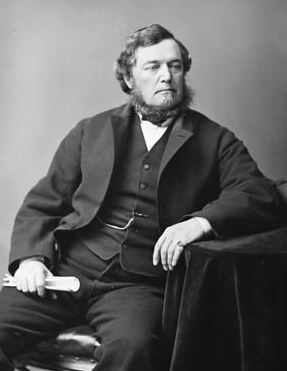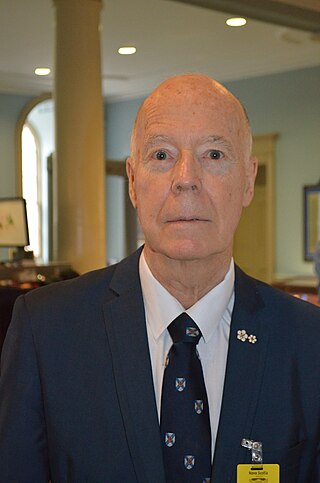Related Research Articles

Sir Charles Tupper, 1st Baronet, M.D. was a Canadian Father of Confederation who served as the sixth prime minister of Canada from May 1 to July 8, 1896. As the premier of Nova Scotia from 1864 to 1867, he led Nova Scotia into Confederation. He briefly served as the Canadian prime minister, from seven days after parliament had been dissolved, until he resigned on July 8, 1896, following his party's loss in the 1896 Canadian federal election. He is the only medical doctor to have ever held the office of prime minister of Canada and his 68-day tenure as prime minister is the shortest in Canadian history.

John William Ritchie was a Canadian lawyer and politician from Annapolis Royal, Nova Scotia who is one of the Fathers of Confederation.

Joseph Howe was a Nova Scotian journalist, politician, public servant, and poet. Howe is often ranked as one of Nova Scotia's most admired politicians and his considerable skills as a journalist and writer have made him a provincial legend.

William Johnston Tupper was a politician and office holder in Manitoba, Canada. He served as the province's 12th Lieutenant Governor from 1934 to 1940.
Henry Poole MacKeen, SM, CD, QC was a Canadian lawyer and the 23rd Lieutenant Governor of Nova Scotia from 1963 to 1968.
Garry Neill Kennedy, was a Canadian conceptual artist and educator from Halifax, Nova Scotia. In the mid-1970s, he created works that investigated the processes and materials of painting. In the first decade of the 2000s, he expanded his work to investigate art and its social, institutional, and political framework.

William Johnston Almon was a Nova Scotian physician and Canadian parliamentarian. He was the son of William Bruce Almon.

Pictou Academy (PA), founded in 1815 by Dr. Thomas McCulloch, is a secondary school in Pictou, Nova Scotia. Prior to the twentieth century, it was a grammar school; a liberal, nonsectarian degree-granting college; and then a secondary school. Pictou Academy's current principal is Starr Pettipas. The Pictou Academy Educational Foundation provides additional funds to the school.

John Clarence Webster was a Canadian physician, surgeon, and pioneer in Obstetrics and gynaecology, topics upon which he wrote several textbooks. After his retirement in 1920 he became a historian, specializing in the history of his native New Brunswick, and a supporter of efforts to preserve heritage and historic sites.

St. Paul's Church is a historically evangelical Anglican church in downtown Halifax, Nova Scotia, within the Diocese of Nova Scotia and Prince Edward Island of the Anglican Church of Canada. It is located at the south end of the Grand Parade, an open square in downtown Halifax with Halifax City Hall at the northern end.

MacCallum Grant was a Canadian businessman and the 12th Lieutenant Governor of Nova Scotia.
William Bennett Webster was a medical doctor, amateur geologist and political figure in Nova Scotia. He represented King's County in the Nova Scotia House of Assembly from 1855 to 1861.
Henry Pryor was a lawyer, magistrate and political figure in Nova Scotia, Canada. He represented Halifax County in the Nova Scotia House of Assembly from 1859 to 1867.

Henry Hezekiah Cogswell was a lawyer, political figure and philanthropist in Nova Scotia. He represented the town of Halifax in the Nova Scotia House of Assembly from 1818 to 1820. He was president of the Royal Acadian School.
Walton, a three-masted barque, was built for the Parker family in Walton, Nova Scotia in 1855. Under the command of Frederick Parker, brother of ground-breaking Halifax/Dartmouth doctor Daniel McNeill Parker, Walton was painted by notable marine artist Michele Renault in 1857 off Livorno (Leghorn), Italy. The painting currently hangs in a private home in Dartmouth, Nova Scotia. In speaking of his uncle, Captain Frederick, family historian William Frederick Parker notes: "His voyages took him chiefly to the Indian and China seas and the Mediterranean, in the barque 'Walton.' He too, lost his life in following his profession. He was never married. His body was interred at Cardiff, Wales. ".

Ronald Daniel Stewart is a Canadian politician. He represented the electoral district of Cape Breton North in the Nova Scotia House of Assembly from 1993 to 1997. He was a member of the Nova Scotia Liberal Party.

Thomas John "Jock" Murray is a Canadian neurologist, medical historian and author.

Andrew Brown was Professor of Rhetoric at the University of Edinburgh and Moderator of the General Assembly of the Church of Scotland in 1813. He was also a historian and author, closely connected to the history of Nova Scotia having served as a minister at St. Matthew's United Church in Halifax.
Arthur William (Bill) Cox, was a Canadian lawyer, practising in Halifax, Nova Scotia. He served overseas during World War II. On his return to Canada, he became an active member of the legal profession, serving as president of the Nova Scotia Barristers' Society (1971–1972), the Federation of Law Societies of Canada (1975–1976) and the Canadian Bar Association. He was also active politically, with both the Progressive Conservative Party of Canada and the Progressive Conservative Party of Nova Scotia.
The Medical Society of Nova Scotia, also known as the Nova Scotia Medical Society or the Provincial Medical Board of Nova Scotia, was established in the 19th century, dedicated to advancing the medical profession and health care in Nova Scotia. It is a division of the Canadian Medical Association (CMA).
References
- Howell, Colin D (1994). "Daniel McNeill Parker". Dictionary of Canadian Biography Online . Retrieved 2008-12-18.